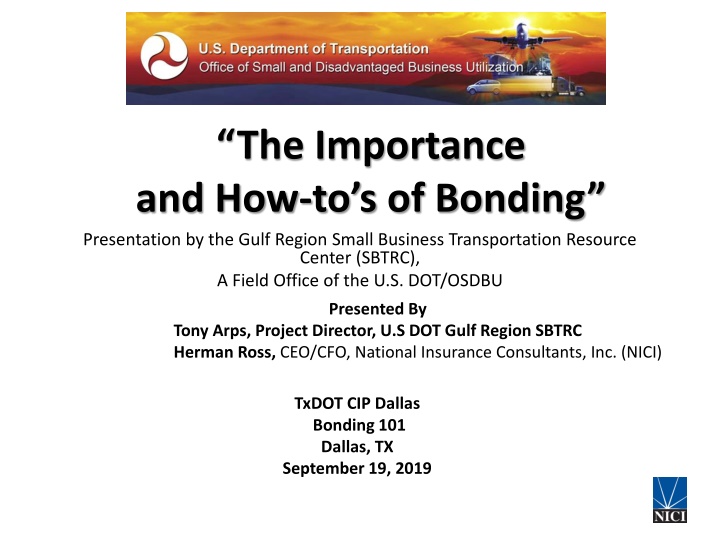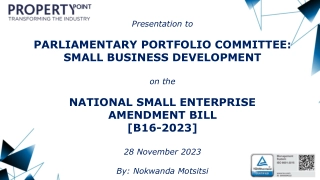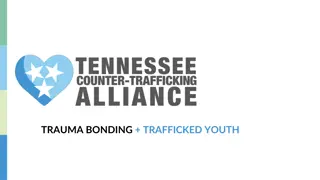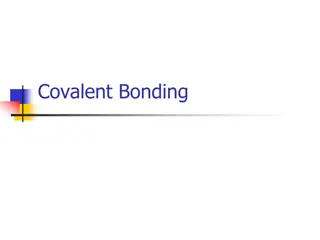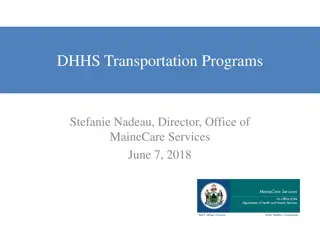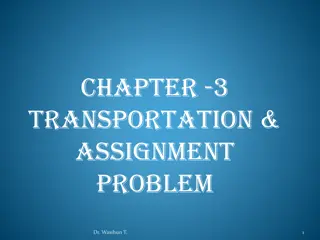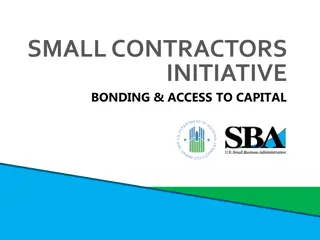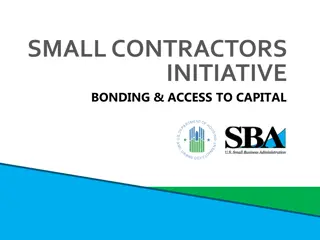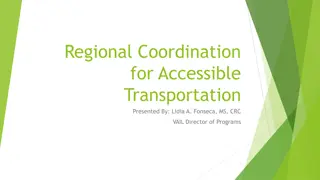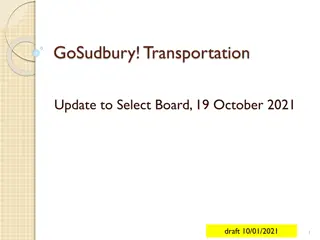Importance of Bonding Presentation in Small Business Transportation
In this presentation by the Gulf Region Small Business Transportation Resource Center (SBTRC), key topics include Surety Bonding, Benefits, Surety Requirements, and Sureties' Criteria. The session also highlights the challenges faced by bondable contractors and issues affecting access to bonding opportunities.
Download Presentation

Please find below an Image/Link to download the presentation.
The content on the website is provided AS IS for your information and personal use only. It may not be sold, licensed, or shared on other websites without obtaining consent from the author.If you encounter any issues during the download, it is possible that the publisher has removed the file from their server.
You are allowed to download the files provided on this website for personal or commercial use, subject to the condition that they are used lawfully. All files are the property of their respective owners.
The content on the website is provided AS IS for your information and personal use only. It may not be sold, licensed, or shared on other websites without obtaining consent from the author.
E N D
Presentation Transcript
The Importance and How-to s of Bonding Presentation by the Gulf Region Small Business Transportation Resource Center (SBTRC), A Field Office of the U.S. DOT/OSDBU Presented By Tony Arps, Project Director, U.S DOT Gulf Region SBTRC Herman Ross, CEO/CFO, National Insurance Consultants, Inc. (NICI) TxDOT CIP Dallas Bonding 101 Dallas, TX September 19, 2019
Overview Who is in the room .which contractor are you? What is Surety Bonding Benefits of Bonding Issues in Access to Bonding Surety Requirements What do Sureties Look for U.S. DOT Bonding Education Program (BEP) A partnership with The Surety & Fidelity Association of America
A bondable Contractor is a sustainable business we see bonding as a challenge not a barrier
Prime Contractors Fail Too Morrison Knudsen (1905-1995) Guy F. Atkinson (1926-1997) J.A. Jones (1890 s-2003) Modern Continental (1967-2008) Ballenger (1937-2012) Truland (1913-2014) Thor (1980-2019)
A bondable Contractor is a sustainable business we see bonding as a challenge not a barrier
A bondable Contractor is a sustainable business we see bonding as a challenge not a barrier
Issues Changes in industry appetite for emerging contractors Lack of understanding of the bonding process Poor credit history Poor financial records and company management Difficulty in identifying appropriate bonding support Breakdown in communications with bond producer/surety company Late entry in the bonding arena Access to Capital Capability and Capacity
What is a Surety Bond A surety bond is a three-party agreement/contract that binds 3 parties together in a legally binding contract. 1. The principal or contractor is the individual or business that purchases the bond to guarantee future work performance. 2. The obligee or owner is the entity that requires the bond. Obliges are typically government agencies working to regulate industries and reduce the likelihood of financial loss. 3. The surety is the insurance company that backs the bond. The surety provides a line of credit in case the principal fails to fulfill the task. If the principal fails to perform as agreed in the contract he bond will cover resulting damages or losses.
Types of Surety Bonds Bid Performance Payment
The bid bond assures that the bid is submitted in good faith and that the contractor will enter into the contract at the price bid and provide the required performance and payment bonds. The performance bond protects the owner from financial loss should the contractor fail to perform the contract in accordance with its terms and conditions. The payment bond assures that the contractor will pay specified subcontractors, laborers, and materials suppliers associated with the project.
How does having a surety bond benefit the Contractor Bonding capacity can increase your project opportunities Bonding is a competitive advantage Objective 3rd party with a broader perspective-evaluating contractors is what they do Access to a trusted advisor and an advocate Deep relationships and understanding of surety and construction
Prequalification Criteria The 3 Cs Capacity - Can the contractor perform the obligations of the contract? Character - Historically, how has the contractor performed? What is the contractor s reputation? Capital - Does the contactor have the financial strength to fulfill the terms of the contract?
Information that the Surety Requires Organizational chart of company Resumes of key personnel Contractor s business plan Financial Statements (last 3 to 5 years) Work in Progress Continuity and contingency plans Subcontractor and supplier references Bank line of credit (if any) or banking reference Letters of recommendation
How to Qualify a Surety Producer References-success stories Does the agent understand the contractor s goals and are they willing to help you get there? Does the agent provide strategic insight and focus on job selection, contract language, cash flow and prime contractor relationships? Does the agent have a true relationship with a range of surety companies?
Surety Market SOFT- Bonds are relatively easy to get Contractors must make the decision of whether they are running a lifestyle business or legacy business There is a substandard market for the surety product There is also a predatory market that focuses on Individual Surety There are agents that engage will customers and help the contractor make decision around project selection, growth projections, strategic engagement and business development
U.S. Department of Transportation Office of Small and Disadvantaged Business Utilization U.S. DOT Bonding and Access to Capital Program A partnership with The Surety & Fidelity Association of America
Objectives Inform and disseminate information to small businesses specializing in transportation-related construction and construction-related goods and services about the bonding process Assist those small businesses to qualify for and have access to bonding or increase their bonding capacity Dispel Myths about bonding Provide a peer learning environment for contractors seeking to build business capacity
Program Overview MOU with Surety Fidelity Association of America (SFAA), USDOT OSDBU provides a Bonding Education Program (BEP) In partnership with the surety industry, OSDBU delivers this multi-component program designed to address the bonding operational improvement opportunities Stakeholder s meeting Educational Component Bond-readiness Component Follow-up assistance
A bondable Contractor is a sustainable business we see bonding as a challenge not a barrier
